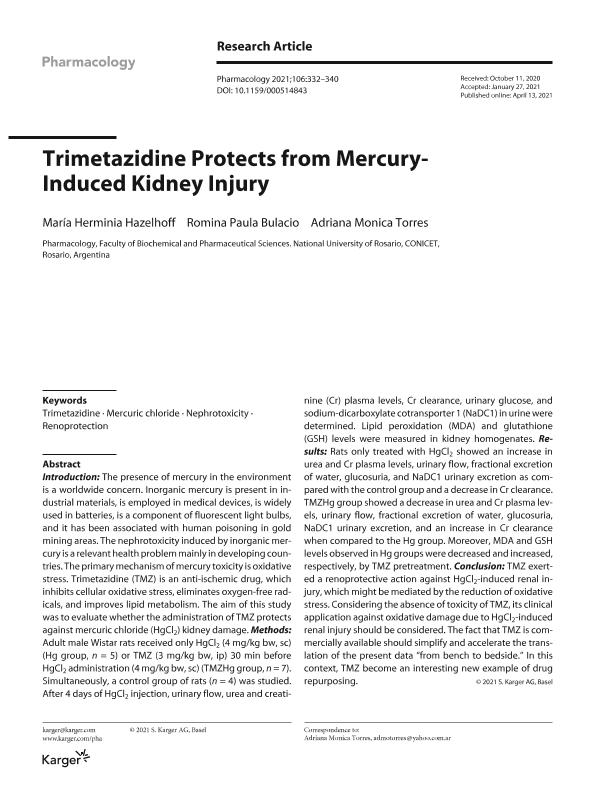Mostrar el registro sencillo del ítem
dc.contributor.author
Hazelhoff, Maria Herminia

dc.contributor.author
Bulacio, Romina Paula

dc.contributor.author
Torres, Adriana Mónica

dc.date.available
2022-05-05T02:10:36Z
dc.date.issued
2021-04-13
dc.identifier.citation
Hazelhoff, Maria Herminia; Bulacio, Romina Paula; Torres, Adriana Mónica; Trimetazidine Protects from Mercury-Induced Kidney Injury; Karger; Pharmacology; 106; 5-6; 13-4-2021; 1-9
dc.identifier.issn
0031-7012
dc.identifier.uri
http://hdl.handle.net/11336/156559
dc.description.abstract
Introduction: The presence of mercury in the environment is a worldwide concern. Inorganic mercury is present in industrial materials, is employed in medical devices, is widely used in batteries, is a component of fluorescent light bulbs, and it has been associated with human poisoning in gold mining areas. The nephrotoxicity induced by inorganic mercury is a relevant health problem mainly in developing countries. The primary mechanism of mercury toxicity is oxidative stress. Trimetazidine (TMZ) is an anti-ischemic drug, which inhibits cellular oxidative stress, eliminates oxygen-free radicals, and improves lipid metabolism. The aim of this study was to evaluate whether the administration of TMZ protects against mercuric chloride (HgCl2) kidney damage. Methods: Adult male Wistar rats received only HgCl2 (4 mg/kg bw, sc) (Hg group, n = 5) or TMZ (3 mg/kg bw, ip) 30 min before HgCl2 administration (4 mg/kg bw, sc) (TMZHg group, n = 7). Simultaneously, a control group of rats (n = 4) was studied. After 4 days of HgCl2 injection, urinary flow, urea and creatinine (Cr) plasma levels, Cr clearance, urinary glucose, and sodium-dicarboxylate cotransporter 1 (NaDC1) in urine were determined. Lipid peroxidation (MDA) and glutathione (GSH) levels were measured in kidney homogenates. Results: Rats only treated with HgCl2 showed an increase in urea and Cr plasma levels, urinary flow, fractional excretion of water, glucosuria, and NaDC1 urinary excretion as compared with the control group and a decrease in Cr clearance. TMZHg group showed a decrease in urea and Cr plasma levels, urinary flow, fractional excretion of water, glucosuria, NaDC1 urinary excretion, and an increase in Cr clearance when compared to the Hg group. Moreover, MDA and GSH levels observed in Hg groups were decreased and increased, respectively, by TMZ pretreatment. Conclusion: TMZ exerted a renoprotective action against HgCl2-induced renal injury, which might be mediated by the reduction of oxidative stress. Considering the absence of toxicity of TMZ, its clinical application against oxidative damage due to HgCl2-induced renal injury should be considered. The fact that TMZ is commercially available should simplify and accelerate the translation of the present data “from bench to bedside.” In this context, TMZ become an interesting new example of drug repurposing.
dc.format
application/pdf
dc.language.iso
eng
dc.publisher
Karger

dc.rights
info:eu-repo/semantics/openAccess
dc.rights.uri
https://creativecommons.org/licenses/by-nc-sa/2.5/ar/
dc.subject
TRIMETAZIDINE
dc.subject
MERCURIC CHLORIDE
dc.subject
NEPHROTOXICITY
dc.subject
RENOPROTECTION
dc.subject.classification
Otras Ciencias Médicas

dc.subject.classification
Otras Ciencias Médicas

dc.subject.classification
CIENCIAS MÉDICAS Y DE LA SALUD

dc.title
Trimetazidine Protects from Mercury-Induced Kidney Injury
dc.type
info:eu-repo/semantics/article
dc.type
info:ar-repo/semantics/artículo
dc.type
info:eu-repo/semantics/publishedVersion
dc.date.updated
2022-03-31T16:31:01Z
dc.identifier.eissn
1423-0313
dc.journal.volume
106
dc.journal.number
5-6
dc.journal.pagination
1-9
dc.journal.pais
Suiza

dc.journal.ciudad
Basilea
dc.description.fil
Fil: Hazelhoff, Maria Herminia. Universidad Nacional de Rosario. Facultad de Ciencias Bioquímicas y Farmacéuticas. Departamento de Ciencias Fisiológicas. Área Farmacología; Argentina. Consejo Nacional de Investigaciones Científicas y Técnicas. Centro Científico Tecnológico Conicet - Rosario; Argentina
dc.description.fil
Fil: Bulacio, Romina Paula. Universidad Nacional de Rosario. Facultad de Ciencias Bioquímicas y Farmacéuticas. Departamento de Ciencias Fisiológicas. Área Farmacología; Argentina. Consejo Nacional de Investigaciones Científicas y Técnicas. Centro Científico Tecnológico Conicet - Rosario; Argentina
dc.description.fil
Fil: Torres, Adriana Mónica. Universidad Nacional de Rosario. Facultad de Ciencias Bioquímicas y Farmacéuticas. Departamento de Ciencias Fisiológicas. Área Farmacología; Argentina
dc.journal.title
Pharmacology

dc.relation.alternativeid
info:eu-repo/semantics/altIdentifier/url/https://www.karger.com/Article/FullText/514843
dc.relation.alternativeid
info:eu-repo/semantics/altIdentifier/doi/http://dx.doi.org/10.1159/000514843
Archivos asociados
